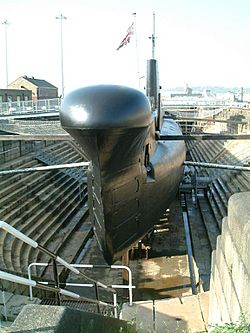HMS Ocelot (S17) facts for kids

HMS Ocelot in drydock at Chatham Historic Dockyard
|
|
Quick facts for kids History |
|
|---|---|
| Name | Ocelot |
| Builder | Chatham Dockyard |
| Laid down | 17 November 1960 |
| Launched | 5 May 1962 |
| Commissioned | 31 January 1964 |
| Decommissioned | August 1991 |
| Status | Preserved as a museum vessel since 1992 |
| General characteristics as designed | |
| Class and type | Oberon-class submarine |
| Displacement |
|
| Length |
|
| Beam | 26.5 feet (8.1 m) |
| Draught | 18 feet (5.5 m) |
| Propulsion |
|
| Speed |
|
| Complement | 68 (6 officers, 62 enlisted) |
| Sensors and processing systems |
|
| Armament |
|
HMS Ocelot (S17) was a special type of underwater boat called a diesel-electric submarine. It was used by the Royal Navy, which is the United Kingdom's navy. This submarine was part of the Oberon class, known for being quiet and effective underwater.
Contents
Building the Ocelot Submarine
The Oberon class submarines were built after the Porpoise-class submarines. They looked similar on the outside and had the same size. However, the Oberon class had newer equipment inside. They also used a stronger type of steel for the pressure hull, which is the main body of the submarine that keeps the water out.
Key Features of the Ocelot
The Ocelot was 295.2 feet (90.0 m) (about 90 meters) long overall. It was 26.5 feet (8.1 m) (about 8 meters) wide. When it was on the surface, it weighed about 2,030 tons. When it was fully underwater, it weighed about 2,410 tons.
How the Ocelot Moved
The submarine used two large diesel engines to make electricity. This electricity powered two strong electric motors. These motors turned two propellers, each about 7-foot-diameter (2.1 m) wide. The Ocelot could travel up to 17 knots (31 km/h; 20 mph) (about 31 kilometers per hour) underwater. On the surface, its top speed was 12 knots (22 km/h; 14 mph) (about 22 kilometers per hour).
Weapons and Crew
The Ocelot had eight torpedo tubes, which are like cannons for torpedoes. Six tubes faced forward, and two faced backward. It could carry a total of 24 torpedoes. The submarine also had special sonar systems (Type 186 and Type 187) to detect things underwater. It had a radar to see things on the surface. A crew of 68 people worked on the Ocelot: 6 officers and 62 sailors.
Ocelot's Construction History
The Ocelot was built at Chatham Dockyard. Work started on 17 November 1960. The submarine was launched into the water on 5 May 1962. It officially joined the Royal Navy on 31 January 1964. The Ocelot was the very last submarine built for the Royal Navy at Chatham Dockyard. However, three more Oberon-class submarines were built there for the Royal Canadian Navy.
Ocelot's Time in Service
After joining the Royal Navy, the Ocelot was sent to the 3rd Submarine Squadron. This squadron was based at HMNB Clyde in Faslane. The Ocelot served there for three years.
Secret Missions and Special Events
During the 1960s, the Ocelot took part in some secret missions. In 1977, the Ocelot was part of a big event called the Silver Jubilee Fleet Review. This was a parade of naval ships off Spithead to celebrate Queen Elizabeth II's 25 years on the throne.
End of Service and Museum Life
HMS Ocelot stopped being an active submarine in August 1991. This happened as the Royal Navy started to use more nuclear-powered submarines instead of conventional ones. In 1992, the Ocelot was sold. It was then saved and turned into a museum ship.
Visiting the Ocelot Today
Today, you can visit the Ocelot at Chatham Historic Dockyard. It is a fully tourable museum, meaning you can go inside and explore it. In November 2013, the inside of HMS Ocelot was even added to Google Street View. This means you can take a virtual tour of the submarine from your computer!
Images for kids




